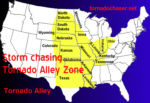You will find Tornado Alley maps will vary from source to source. So this
is only one opinion of many. Here is what Tornado Tim Baker thinks.
Are traditional tornado alley maps wrong?
Some consider tornado alley as the area where only the most intense killer tornadoes are
likely to occur, looking where F4 and F5 tornadoes have struck in history multiple times.
Others draw tornado alley only where tornado frequency is the highest, looking at areas
that have recorded multiple tornado touchdowns consistently year after year. Some years
certain states seem to get enough tornadoes to qualify as part of tornado alley but, when
looking at tornadoes over many years in that state you see that it was just an unusual
period for them. With many areas experiencing warmer than
normal temperatures, traditional tornado alley maps don't seem
to represent those climate changes accurately. I believe we
need to rethink where tornado alley is with these climate changes. A
warm January will lead to a shift in tornadoes to more north and
eastern states than traditional tornado alley maps represent.Many arguments over what states are in
tornado alley take place, so to be fair qualify what criteria you are using in determining
tornado alley. In 2004 people in Illinois were at greater risk than most of the
areas people think of as tornado alley.
If you were to be exact about tornado alley, it would
really be made up of hundreds of little strips, and never one large alley. Tornado
alley maps are all made up of a general area from data taken over a long period of time.
Tornado alley should be thought of on a more yearly basis also, since weather patterns can
change, making some states harder hit one year versus others, like Illinois in 1925, 1974
and 2004.
Some people have asked if
tornadoes appear everywhere in tornado alley. The fact is on all tornado alley maps there
are areas that have never had a tornado hit there. Remember, not every city in
tornado alley has been struck by a tornado while others have had many tornadoes hit them.
Heavy winds from tornadoes and other
storms can cause widespread damage to the local trees. Those
affected by storms in the eastern states should consider this
tree removal Raleigh based
company to clear any debris left by storms. I would also suggest you
remove any dead limbs before storm season starts. I have seen
many houses and cars with an old limb crashed through their roof.
Why not be proactive. Give them a call today.

The 1974 super tornado outbreak took place in Georgia, Illinois,
Indiana, Kentucky, Michigan, Mississippi, North Carolina, Ohio, South Carolina, Tennessee,
Virginia, and West Virginia. How many maps include these states in Tornado Alley? Not very
many, some don’t include any of them; even I don’t include all of them. States
such as Florida also have many small tornadoes but because the intensity of most of them
is low, it is seldom considered as part of Tornado Alley by anyone. In 1925 the Tri-State
tornado killed 695 people in Missouri, Illinois and Indiana, yet many don’t include
these in Tornado Alley, I do. In November 2002 a tornado outbreak took place in
Alabama, Tennessee and Ohio, Killing at least 36 people. Friday, September 20th 2002 a
tornado outbreak hit Indiana, I include these states in Tornado Alley, others don't.
History tells me Indiana, Ohio, Illinois, Kentucky and Tennessee are dangerous tornado
states.(cont. top)

• Chaser School - What is CAPE
• Upper air - Jet streams and chasing
• Historical
Tornado Photos
• Meteorology
Programs
• Degree
Programs
• Storm
Chasers
Tornado Tim Safety Photos and posters |
Below is a Map of Tornado
Alley

The area I have marked covers the states that have recorded an F5
tornado touchdown, except Colorado and Arkansas. Colorado and Arkansas are still included
because they record many smaller tornadoes each year and have had significant tornadoes in
their history. So the area marked on this map as tornado alley is based on where
dangerous tornadoes and tornadoes in general are most likely going to take place in a
given year. This area averages 3 tornadoes or more per year per 10,000 square miles
in general.

The dark green areas on the map below could be considered the
heart of tornado alley, especially in Nebraska, Kansas, Oklahoma and Texas. Notice how not
all dark green areas are in Kansas, Oklahoma and Texas, the area many limit tornado alley
to. Look at both maps to get a better idea.

|
